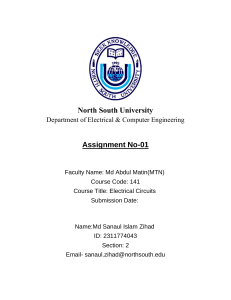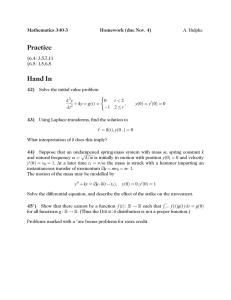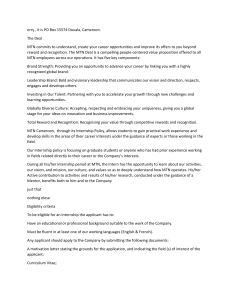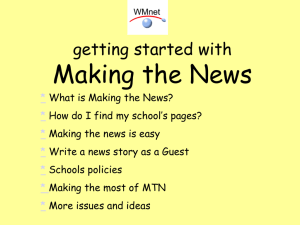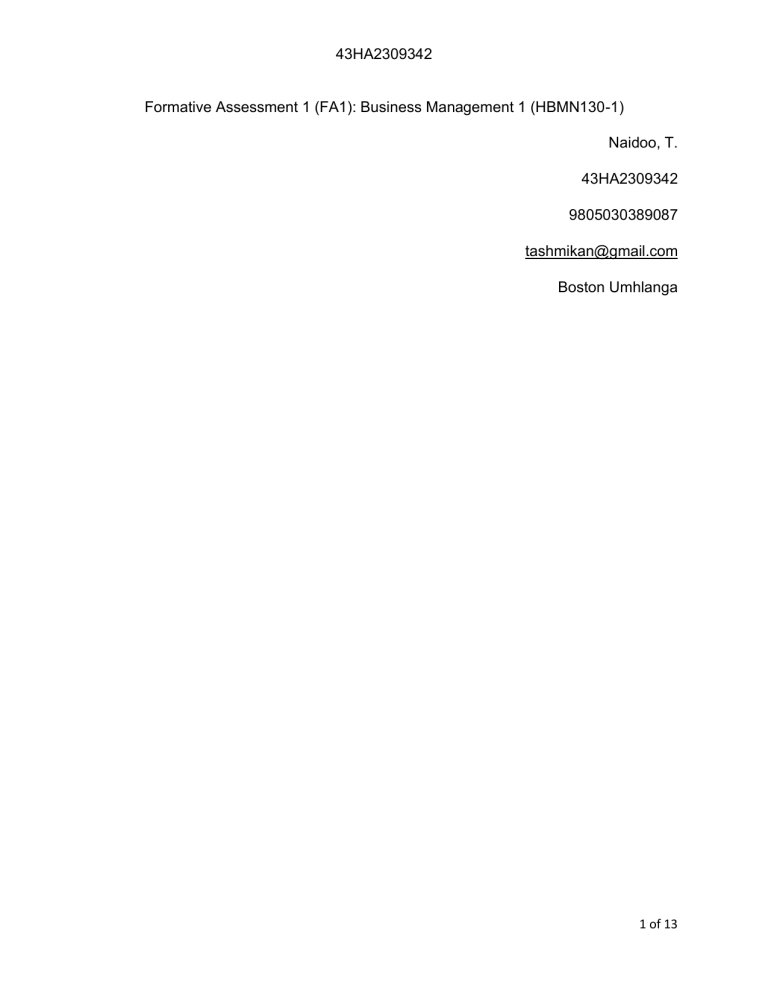
43HA2309342 Formative Assessment 1 (FA1): Business Management 1 (HBMN130-1) Naidoo, T. 43HA2309342 9805030389087 tashmikan@gmail.com Boston Umhlanga 1 of 13 43HA2309342 Question 1 1.1. 1. The first managerial role of managers at MTN is the interpersonal role. This role focuses on managers being people-centric whilst keeping in line with the organisations goals and objectives. Managers need three sub-roles to fulfill this role. → Figurehead: As a figurehead, the managers must represent their relevant department, section, or organisation by performing ceremonial and symbolic duties. A few examples of some of the tasks that will need to be performed by the managers are organising luncheons for important clients or customers, attending social events, and attending community activities (Botha and Vrba, 2021:51). Figureheads are also responsible for encouraging their teams to achieve the goals and aims of the organisation. They present a positive and professional picture; they also hold the authority and respect of their team members (Smirti, 2021). → Leader: This sub-role involves the manager overseeing and assisting the performance of team members, thus allowing the manager to lead his or her teams effectively and efficiently to achieving the goals and objectives of the organisation. For example, if the manager's team needs to meet a particular sales goal within a period, then the manager must thoroughly indicate his or her expectations to his or her team. During this period, the manager is expected to support his or her team by navigating the workflow and supplying the necessary resources required to achieve the goal (Indeed Editorial Team, 2022). → Liaison: The role of the liaison is to ensure that the organisation develops solid relationships both inside and outside its walls. Managers must ensure that they are politically aware of all organisational problems in order to successfully network and establish connections within and outside of the organisation (Botha and Vrba, 2021:51). The results of strong connections and networking open doors for opportunities such as organisational collaborations and advancements 2 of 13 43HA2309342 (By the Mind Tools Content Team, n.d.). For example, the managers at MTN will be able to liaise with customers/clients to gather information on their demands, queries regarding customer service delivery and product delivery, and overall expectations of the MTN branch thus they will be able to effectively communicate this to their teams and transform this into positive outputs. (Indeed Editorial Team, 2022) 2. The second managerial role is the information role. This role allows the manager to gain information about colleagues, employees, departmental heads, as well as outside individuals and organisations. The three sub-roles in this role are the role of monitor, disseminator, and spokesperson. → Monitoring is a process whereby information on global, environmental, or industry trends are monitored or gathered by the managers and analysed (Botha and Vrba, 2021:51). For example, if a competitor launches an innovative product, then the manager will evaluate the steps that need to be carried out to meet their organisational standards whilst remaining competitive (Indeed Editorial Team, 2022). → Disseminator: Managers are required to disseminate necessary data or information to their superiors or team members (Botha and Vrba, 2021:51). For example, if the manager creates a proposal for an innovative product design after monitoring the industry trends, he or she will present this design to higher management for approval, and their team will follow suit if approved (Indeed Editorial Team, 2022). → Spokesperson: The managers represent the organisation or their department by acting as a spokesperson (Botha and Vrba, 2021:51). Managers also communicate information to stakeholders, such as the goals and policies of the organisation, and represent their teams in internal meetings. As an example, the manager needs to attend the annual shareholders’ meeting. He or she must speak on behalf of the organisation or his or her team, providing necessary insights (Indeed Editorial Team, 2022). 3 of 13 43HA2309342 3. The third managerial role is decision-making. Managers must be able to make strategic decisions in the best interests of the organisation as a whole. We look at four sub-roles under this managerial role. → Entrepreneurs: Managers need to set up projects and capitalise on contemporary trends that can be found in the monitoring role (Botha and Vrba, 2021:51). They must encourage change and creativity. They should also produce and put into action innovative ideas that benefit the organisation. As an example: The sales of a newly launched product have noticeably slowed down. The manager should then assess what needs to be done to achieve a successful output. This can be done by developing current marketing strategies and ways of reaching clients or customers (Peek, 2023). → Problem-solving: Should any issues arise within the department or section that the manager handles, then the manager will deal with the issue accordingly. For example, the manager can deal with angry clients or customers, negotiate with difficult suppliers, or assist in an employee disagreement (Botha and Vrba, 2021:52). → Resource allocator: It is the duty of managers to distribute an organisations resources and determine where they will be most useful, so that the most favourable outputs are achieved. For example, the manager is required to set the organisations budget for the departments or sections managed. In fulfilling this, he or she will decide on how to distribute funds among the department or section in accordance with the requirements or objectives of the specific department or section (Indeed Editorial Team, 2022). → Negotiator: The manager deals with internal and external individuals, other departments or organisations, and trade unions (Botha and Vrba, 2021:52). For example, if a team member requiress a salary increase, and the request cannot be met then the manager will negotiate this request and offer a solution that satisfies both the organisation and the team member (Indeed Editorial Team, 2022). Question 2 4 of 13 43HA2309342 The market environment is the environment in which an MTN competes with others in the industry. The environment comprises the following sub-environments; customers, competition, the labour market and labour unions, intermediaries, suppliers. → Customers in the market environment are the reason why MTN exists, which is why the main goal is to satisfy the customer's needs in order to gain their loyalty. It is extremely imperative for MTN to have an in-depth understanding of the characteristics, needs, and expectations of their customers to be able to survive. Customers use bargaining power, purchasing power, and buyer behaviour in order to obtain the highest quality, quantity, and most cost-effective product or service from the organisations in the industry. This in turn creates a competitive environment for the organistations as there is now a need to retain customers by offering the most affordable, high-quality, and quantity products and services. → Other than customers, MTN's competitors are the most significant daily force it must contend with. Because other organisations in the same industry offer basically the same goods and services, there is fierce competition to retain customers. For MTN to compete successfully against its competitors, a competitor analysis can be done to aid in understanding, interpreting, and predicting the actions and responses of its competitors. → MTN’s labour market is extremely versatile. Employing people with various skill levels, age groups, sexes, and geographical regions aids the organisation in achieving its success. Due to the temporary nature of employment relations, there is a lot of fluidity and unpredictability in the labour market which is why MTN focuses on attracting and retaining capable employees. The nature of MTN’s internal and external environments creates a profound influence on the employee recruitment process. To ensure success in this aspect, MTN focuses on building a compelling reputation as an employer and providing stable economic conditions and employment rates. When the availability of people with the required skills becomes scarce, MTN will try to compete with other organisations within the industry for competent labour. In such cases we see the labour unions playing an integral role in this regard. 5 of 13 43HA2309342 → Intermediaries are individuals or companies that present MTN's products and services to customers in different capacities. They are the link that lies between MTN and the final customers, their role is integral and indirectly and directly affects the organisation. Intermediaries include wholesale, retailers, agents, and brokers. → MTN needs inputs in order to produce outputs, these inputs are procured from suppliers and are identified as human resources, capital, technology, and information. The conversion of inputs to outputs is done through a process that involves a chain of activities to produce valuable products and services for the market served. This is known as the value chain and by utilising this, value is created for all role-players, and a lasting competitive advantage is created for MTN. The availability of suppliers and alternative supplies are extremely important for the functioning of the organisation. This factor also leads to the bargaining power of suppliers. 2.2 Customers: → A customer had trouble using their new digital device that was purchased from the Canal Walk branch. The customer was able to call the agent that helped with the purchase and received a step-by-step breakdown of how to resolve the issues experienced. → When customers enter the Canal Walk branch, they are immediately met with smiling and cheerful staff who offer prompt assistance according to the customer’s needs. → A loyal MTN customer had come into the Canal Walk branch to take out a new mobile contract. However, they had seen a similar contract with Vodacom, a competitor company of MTN, and hoped that they could take the same deal with MTN due to their long-term loyalty. Discussions were made with management and a deal was made to honour and retain the customer's support. Competitors: 6 of 13 43HA2309342 → MTN’s largest competitor Vodacom was founded in the same year which means that the pricing, products, and quality are similar. Due to this similarity, MTN consistently works on innovative products and services and marketing tactics to keep the interest of customers high and in their favour. → MTN focuses on achieving economies of scale as this creates a great barrier for new telecom organisations in the market. → MTN focuses on uniqueness through quality, price, designs, brand image, and customer service. This type of differentiation gives them an advantage over other telecom organisations in the market by locking in customer loyalty to their products and services. Labour market: → MTN recruits highly competent and skilled individuals so that the organisation fully benefits from the position. For example, MTN hired a lower-level manager, who was well-equipped with years of experience. The manager led their team to remarkable success due to this aspect. → MTN retains employees by providing competitive compensation packages and benefits. → MTN focuses on maintaining a strong employer reputation. This is achieved through a transparent organisational mission and a collection of core values, which in turn attract the right labour market. Intermediaries: → MTN products and services are brought to their customers through retailers that can be found in various locations across the continent, specifically shopping malls. → MTN offers an intermediary Device Insurance Policy that is a single point of contact for any device insurance needs required by their customers. → MTN offers local businesses the opportunity to offer and distribute their services and products, for example, sim card packs, and airtime. Suppliers: 7 of 13 43HA2309342 → In order to recruit human resources, MTN has a ‘career page’ on their website that includes a list of jobs available at various branches. Each listed position will include requirements, such as skill, qualification, experience, and overall duties. The most competent applicant will be chosen. → MTN largest electronics supplier is Dell Technologies, they obtain electronic devices, software and hardware, as well as IT services from the company. → MTN had partnered with the World Banks International Finance Corporation (IFC) to expand its mobile money business. The IFC contributed $1 million, which was matched by MTN. During the COVID-19 pandemic, MTN's mobile money (MoMo) company saw an increase in transaction values and user numbers as mobility restrictions and the avoidance of physical cash drove people to mobile money platforms. The partnership will target the unbanked and underbanked populations by creating a powerful network of Momo agents who will perform cash transfers on customers' behalf (Dludla, 2021). Question 3 3.1.1. Generational Alpha 3.1.2. Generation X 3.1.3. Generation Z 3.1.4. The Silent Generation 3.1.5. Generation Y 3.1. → Avoidance: A conflict is avoided or suppressed by one or both parties. → Accommodation: One party is prepared to consider the needs of the other in order to resolve the conflict, find a solution, or keep things as they are. → Compromise: Agree on a compromise and both parties give up something. → Competition: One or both parties are only concerned with their own interests, which leads to dysfunctional conflict and a win-lose outcome. 8 of 13 43HA2309342 → Collaboration: Both parties discuss their differences and reach a win-win solution where everyone gains. 3.2 → Personal differences: Conflict arises from personal differences between individuals stemming from demographic factors such as background, race, culture, age, levels of education, worldviews, and value systems. → Communication breakdown: Poor communication and misinformation create negative perceptions resulting in interpersonal conflict. → Role incompatibility: Different interdependent roles and functions of authority figures could lead to interpersonal conflict if they are incompatible with one another. → Environmental stressors: High levels of stress brought upon by the external and internal environment can cause interpersonal conflict. → Competing for the same position: When individuals compete for the same scarce position. Depending on the available opportunities within the organisaiton, this could lead to intense competition and conflict surround the available position. 3.3 Psychological symptoms: → Loss of objectivity and fearful anticipation → Constant feelings of uncertainty or insecurity → Racing thoughts and constant worrying Physical symptoms: → Nausea → Palpitations (heart) Question 4 The concept of culture can be described as a fundamental aspect of life. A basic meaning would be ‘being cultured,’ in other words, being human. It is the way people 9 of 13 43HA2309342 behave considering all influencing variables and the ability to use these variables to positively influence others. Culture can be found everywhere at any given time. We see numerous studies, dating back to the 1930s, that concentrate on the unique culture of organisations. Due to the complexity of the term ‘culture’ there has been an array of definitions from diverse fields on what organisational culture is. Edgar H Schein, a management scientist created a definition for the concept of which is most prominent (Botha and Vrba, 2021:152-153). "Schein defines culture as everything an organization has learned throughout its history" (Minute Tools Content Team, 2022). Schein’s definition of organisational culture is the pattern of basic assumption, which is the core of the culture in any organisation. He further states that these assumptions were developed as a coping mechanism to its problems of external adaption and internal integration and due to the consistent success of these assumptions, they are imparted to future generations as the right way to perceive, think about, and feel about those problems (Schein, 1990). Due to South Africa's diversity, organisational culture was seen as a challenge. However, over time organisational cultures evolved, and many organisations share somewhat similar norms and values. Here are a few examples of the way things are done: Just Landed (2014) explains: • The use of humour in moderation is accepted when conducting business, it is mostly used as an ice breaker. • South Africans greet with a firm handshake paired with eye contact. • When it comes to female's its best to wait for them to lend their hand out as majority of the time, they offer greetings by a simple node and smile. South Africa (n.d) explains: • It is uncommon to schedule meetings between mid-December and mid-January, as this is prime holiday time in South Africa, and they place extreme emphasis on year-end holidays and their activities. 10 of 13 43HA2309342 • South Africans prefer to physically engage with others, rather than having meetings via technology. In conclusion, having culture within an organisation is imperative for the long-lasting success and survival of any organisation. 11 of 13 43HA2309342 Reference List ▫ Botha, T. and Vrba, M. (2021) Contemporary Management Principles. 2nd edn. Capetown: Juta and Company. ▫ By the Mind Tools Content Team (n.d.). Mintzberg’s Management Roles Identifying the Roles Managers Play. MindTools [website]. Retrieved from https://www.mindtools.com/ajfb1ev/mintzbergs-management-roles [Accessed 24 Mar. 2023]. ▫ By the Mind Tools Content Team (n.d.). Professional Networking Building Relationships for Mutual Benefit. MindTools [website]. Retrieved from https://www.mindtools.com/aany5dn/professional-networking [Accessed 24 Mar. 2023]. ▫ Dludla, N. (2021). MTN South Africa teams up with World Bank’s IFC on mobile money. Nasdaq [website]. Retrieved from https://www.nasdaq.com/articles/mtnsouth-africa-teams-up-with-world-banks-ifc-on-mobile-money-2021-05-19 [Accessed 1 Apr. 2023]. ▫ Indeed Editorial Team (2021). 10 Managerial Roles According to Mintzberg. Indeed Career Guide [website]. Retrieved from: https://www.indeed.com/careeradvice/finding-a-job/managerial-role [Accessed 24 Mar. 2023]. ▫ Just Landed. (2014). Business culture in South Africa [website]. Retrieved from: https://www.justlanded.com/english/South-Africa/South-AfricaGuide/Business/Business-culture-in-South-Africa [Accessed 5 Apr. 2023]. ▫ Minute Tools Content Team (2022). Edgar Schein’s Organizational Culture Model. Expert Program Management [website]. Retrieved from: https://expertprogrammanagement.com/2022/09/edgar-schein-culture-model/ [Accessed 5 Apr. 2023]. ▫ Peek, S. (2023). The Management Theory of Henry Mintzberg Basics. Business.com [website]. Retrieved from: https://www.business.com/articles/management-theory-of-henry-mintzbergbasics/ [Accessed 26 Mar. 2023]. 12 of 13 43HA2309342 ▫ Schein, E.H. (1990). Organizational culture. American Psychologist, 45(2):109– 119. doi:https://doi.org/10.1037//0003-066x.45.2.109. ▫ Smirti (2021). Managerial Roles - 3 Types of Managerial Roles | Principlesof Management. Management Notes [website]. Retrieved from https://www.managementnote.com/managerial-roles/ [Accessed 24 Mar. 2023]. ▫ South Africa. (n.d.). Business Etiquette In South Africa [website]. Retreived from: https://www.southafrica.net/gl/en/travel/article/business-etiquette-in-south-africa [Accessed 5 Apr. 2023]. 13 of 13
